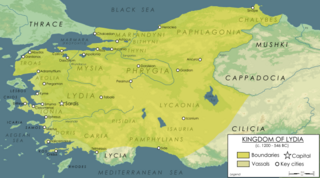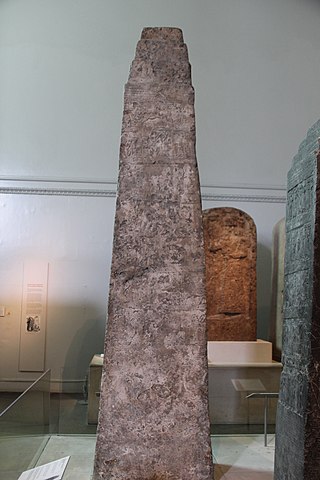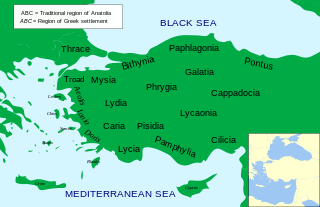Related Research Articles

Abydos was an ancient city and bishopric in Mysia. It was located at the Nara Burnu promontory on the Asian coast of the Hellespont, opposite the ancient city of Sestos, and near the city of Çanakkale in Turkey. Abydos was founded in c. 670 BC at the most narrow point in the straits, and thus was one of the main crossing points between Europe and Asia, until its replacement by the crossing between Lampsacus and Kallipolis in the 13th century, and the abandonment of Abydos in the early 14th century.

Lydia was an Iron Age kingdom of western Asia Minor located generally east of ancient Ionia in the modern western Turkish provinces of Uşak, Manisa and inland Izmir. The ethnic group inhabiting this kingdom are known as the Lydians, and their language, known as Lydian, was a member of the Anatolian branch of the Indo-European language family. The capital of Lydia was Sardis.

Hellenistic Greece is the historical period of the country following Classical Greece, between the death of Alexander the Great in 323 BC and the annexation of the classical Greek Achaean League heartlands by the Roman Republic. This culminated at the Battle of Corinth in 146 BC, a crushing Roman victory in the Peloponnese that led to the destruction of Corinth and ushered in the period of Roman Greece. Hellenistic Greece's definitive end was with the Battle of Actium in 31 BC, when the future emperor Augustus defeated Greek Ptolemaic queen Cleopatra VII and Mark Antony, the next year taking over Alexandria, the last great center of Hellenistic Greece.
Agron was an Illyrian king of the Ardiaean Kingdom in the 3rd century BC, ruling c. 250–231 BC. The son of Pleuratus II, Agron succeeded in reconquering southern Illyria, which had been under the control of Epirus since the time of Pyrrhus, and in extending Illyrian rule over many cities in the Adriatic region, including Corcyra, Epidamnos, and Pharos.

Aššur-nāṣir-apli I, inscribed maš-šur-PAB-A, “the god Aššur is the protector of the heir,” was the king of Assyria, 1049–1031 BC, and the 92nd to appear on the Assyrian Kinglist. He was the son and successor of Šamši-Adad IV, and he ruled for 19 years during a troubled period of Assyrian history, marked by famine and war with nomads from the deserts to the west. He is best known for his penitential prayer to Ištar of Nineveh.
Šamši-Adad IV, inscribed mdšam-ši-dIM, was the king of Assyria, 1054/3–1050 BC, the 91st to be listed on the Assyrian Kinglist. He was a son of Tukultī-apil-Ešarra I, the third to have taken the throne, after his brothers Ašarēd-apil-Ekur and Ashur-bel-kala, and he usurped the kingship from the latter’s son, the short-reigning Erība-Adad II. It is quite probable that he was fairly elderly when he seized the throne.
Erība-Adad II, inscribed mSU-dIM, “Adad has replaced,” was the king of Assyria 1056/55–1054 BC, the 94th to appear on the Assyrian Kinglist. He was the son of Aššur-bēl-kala whom he briefly succeeded and was deposed by his uncle Šamši-Adad IV.
Erato was a queen of Armenia from the Artaxiad dynasty. She co-ruled as Roman client queen in 8–5 BC and 2 BC–AD 1 with Tigranes IV. After living in political exile for a number of years, she co-ruled as Roman client queen from 6 until 12 with Tigranes V, her distant paternal relative and possible second husband. She may be viewed as one of the last hereditary rulers of her nation.
Aššūr-bēl-nīšēšu, inscribed 𒁹𒀭𒀸𒋩𒂗𒌦𒈨𒌍𒋙mdaš-šur-EN-UN.MEŠ--šú, and meaning “(the god) Aššur (is) lord of his people,” was the ruler of Assyria c. 1417–1409 BC or 1407–1398 BC, the variants due to uncertainties in the later chronology. He succeeded his father, Aššur-nērārī II, to the throne and is best known for his treaty with Kassite king Karaindaš.
Aššur-šaddûni or -šaduni, inscribed maš-šur-KUR-ú-ni or [maš-šur-K]UR-u-ni and meaning “(the god) Aššur (is) our mountain,” was the ruler of Assyria for just "one complete month" during the 15th century BC, the 64th to appear on the Assyrian King List. He succeeded his father, Nur-ili, but was ousted in a coup by his uncle, Aššur-rabi I.
Puzur-Ashur III was the king of Assyria from c. 1521 BC to 1498 BC. According to the Assyrian King List, he was the son and successor of Ashur-nirari I and ruled for 24 years. He is also the first Assyrian king to appear in the synchronistic history, where he is described as a contemporary of Burnaburiash of Babylon. A few of his building inscriptions were found at Assur. He rebuilt part of the temple of Ishtar in his capital, Ashur, and the southern parts of the city wall.
Parthus or Parthos was a settlement of the Illyrian tribe of the Parthini in southern Illyria, modern Albania. Although different sites in central Albania have been proposed, its exact location has not yet been found.
Ancient Armenia refers to the history of Armenia during Antiquity. It follows Prehistoric Armenia and covers a period of approximately one thousand years, beginning at the end of the Iron Age with the events that led to the dissolution of the Kingdom of Urartu, and the emergence of the first geopolitical entity called Armenia in the 6th century BC. Highlights of this period include the rise of ancient Armenia as an important state in Western Asia in the 4th century BC; a briefly held empire under Julius Caesar's contemporary the Great King Tigranes II ; the kingdom's official conversion to Christianity in 301; and the creation of the Armenian alphabet in the year 405. It concludes with the demise of the Armenian kingdom and the country's partition later in the 5th century, marking the beginning of Medieval Armenia.

Classical Anatolia is Anatolia during Classical Antiquity. Early in that period, Anatolia was divided into several Iron Age kingdoms, most notably Lydia in the west, Phrygia in the center and Urartu in the east. Anatolia fell under Achaemenid Persian rule c. 550 BC. In the aftermath of the Greco-Persian Wars, all of Anatolia remained under Persian control except for the Aegean coast, which was incorporated in the Delian League in the 470s BC. Alexander the Great finally wrested control of the whole region from Persia in the 330s BC. After Alexander's death, his conquests were split amongst several of his trusted generals, but were under constant threat of invasion from both the Gauls and other powerful rulers in Pergamon, Pontus, and Egypt.

Luhuti, Lukhuti or Lu'ash, was an Iron Age Syro-Hittite Aramean region during the early 1st millennium BC located in northern Syria, in an area that used to be called Nuhašše.
Urshu, Warsuwa or Urshum was a Hurrian-Amorite city-state in southern Turkey, probably located on the west bank of the Euphrates, and north of Carchemish.
The Hittite Navy was the main naval force of the Hittites from ca. 16th–12th century BC. The navy took part in three land and sea military campaigns of the Hittite Kingdom against the Kingdom of Alashiya between 1275 and 1205 BC. It was also one of the main adversaries of the Egyptian Navy.
Cyril John Gadd, was a British Assyriologist, Sumerologist, and curator. He was Keeper of the Department of Egyptian and Assyrian Antiquities, British Museum from 1948 to 1955, and Professor of Ancient Semitic Languages and Civilizations at the School of Oriental and African Studies, University of London from 1955 to 1960. Having served in the British Army during the First World War, he joined the British Museum after demobilisation and also worked on excavations at Ur, Carchemish, Alalakh and Nimrud. Having risen to Keeper, he left the British Museum to enter academia, and was appointed professor emeritus on his retirement in 1961.
References
- ↑ Rhodes, P. J. "The Cambridge Ancient History" (PDF). Retrieved 28 March 2013.
- ↑ Westermann, William Linn (1928). "The Progress of the Cambridge Ancient History". Political Science Quarterly. 43 (2): 266. doi:10.2307/2143304. JSTOR 2143304.
- ↑ Rhodes, P. J. "The Cambridge Ancient History" (PDF). p. 19. Retrieved 28 March 2013.
- ↑ Rhodes, P. J. "The Cambridge Ancient History" (PDF). p. 21. Retrieved 28 March 2013.